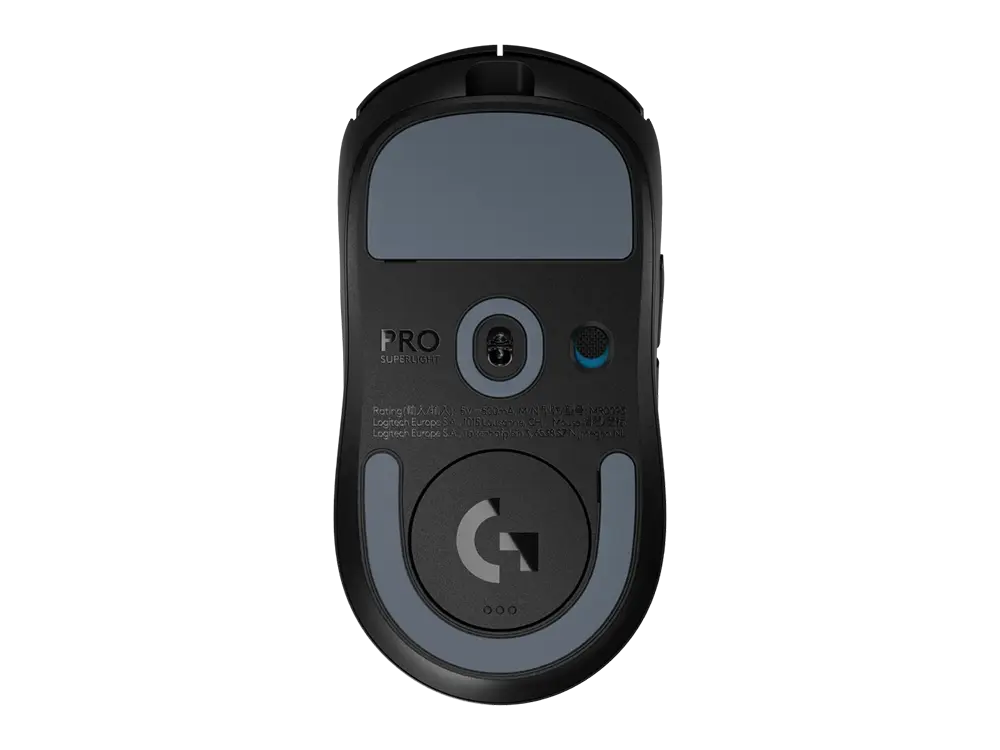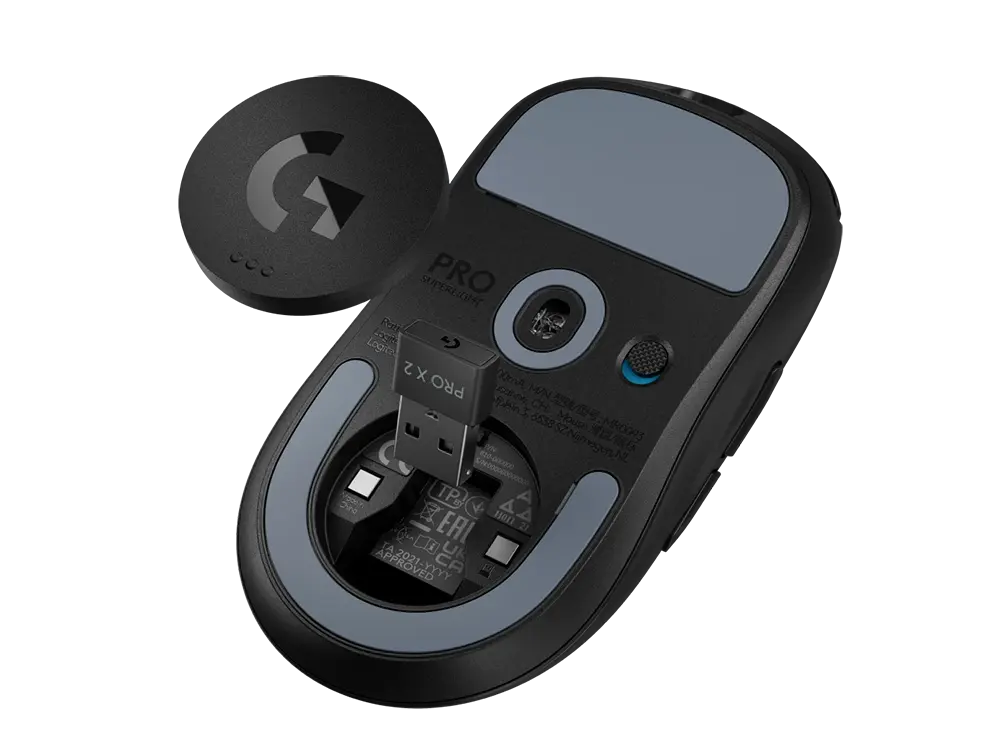Pros
• Extremely lightweight (60g).
• Highly responsive main buttons.
• Comfortable ergonomics for gaming.
• Ultra-accurate sensor.
• Outstanding battery life.
Cons
• Designed solely for right-hand users.
• No dedicated sensitivity adjustment button.
• Lacks Bluetooth capability.
| TECHNICAL | SPECIFICATIONS |
|---|---|
| Onboard memory | Yes |
| No-additive PTFE Feet | Yes |
| 5 buttons | Yes |
| TRACKING | Yes |
| Sensor | HERO 2 |
| Resolution | 100 – 32000 dpi 2 |
| Max. acceleration | >40 G 3Tested on Logitech G240 Gaming Mouse Pad |
| Max. speed | >500 ips 4Tested on Logitech G240 Gaming Mouse Pad |
| RESPONSIVENESS | Max Report Rate: 2000Hz (0.5 ms) 5 |
| Microprocessor | 32-bit ARM |
| BATTERY LIFE | Constant motion 95 Hrs |
Following the well-received G Pro X Superlight in 2021, Logitech has introduced its new G Pro X Superlight 2, targeting professional gamers. It arrives with an improved sensor and optical switches, promising even better performance.
Overview
After launching the G Pro Wireless in 2018 and then the G Pro X Superlight in 2021, Logitech updates its flagship gaming mouse, taking on rivals like Razer with their Viper V2 Pro and Deathadder V3 Pro. Technically, this is a welcomed upgrade, although it’s not groundbreaking. When Logitech mentions “pro range”, they imply a higher price point. Expect to part with a tidy sum of £170 for this state-of-the-art G Pro X Superlight 2, available in black, white, or pink. While waiting for the first discounts, bear in mind that the previous version is still on sale for around £100 as of writing, which might be worth considering if you’re budget-conscious.
Ergonomics
Why change a winning formula? It’s a mantra for Logitech, whether for office or gaming models. The G Pro X Superlight 2 very much mimics the design of its predecessor. With its matte black plastic, non-illuminated G logo, white scroll wheel, side buttons, and overall dimensions of 125 x 63.5 x 40 mm, it’s all there. The only difference is its weight, now at 60g, a 3g reduction from before. This firmly places the model in the ultra-lightweight category. While other manufacturers might offer even lighter options, it’s worth noting that weight isn’t everything.
Given its featherlight weight and contoured design, this mouse is perfectly suited for FPS (first-person shooter) games, enabling rapid movements on the mouse pad whether you use palm grip, claw grip, or fingertips. While its smooth coating might be a bit slippery for some, Logitech includes textured stickers to enhance grip on the sides or main buttons, adding a mere gram to its weight. It’s good to see users given the choice.
A significant feature of this mouse is its main buttons. Logitech has incorporated hybrid Lightforce optical/mechanical switches, aiming to deliver the best of both worlds. These switches, already found in the brand’s recent G502 X, activate when a physical element crosses a laser path, ensuring top-notch responsiveness. Yet, they retain the tactile feel of mechanical buttons thanks to a metal component inside. In use, these buttons don’t differ much from the optical switches competitors offer, but they are impressively responsive and provide an unmatched tactile feedback. The actuation is distinct and the rebound instantaneous. Two minor drawbacks, however, are the somewhat noisy clicks and the slightly heavier force required for activation.

The side buttons are standard yet responsive, albeit a tad softer than those on Razer’s competitors. These buttons are also securely fixed in place, ensuring a seamless gaming experience. As for the scroll wheel, it’s the same as it was two years ago: notched, straightforward, and efficient. For additional features, like free or lateral scrolling, you might consider the G502 X from the manufacturer – though it’s significantly heavier. A small LED light illuminates above the scroll wheel when adjusting sensitivity, indicating the level (400, 800, 1000 dpi, etc.), which is handy to check without having to refer to the app.
One oversight is the lack of a dedicated sensitivity adjustment button on the G Pro X, not even underneath! This means you’ll need to allocate this function to an existing button (either on the side or the wheel), which could limit in-game actions. The alternative is navigating to the G Hub software to manually select the desired setting. It’s true that one doesn’t usually adjust sensitivity mid-game, but it can be a tad inconvenient when switching from everyday tasks to gaming.
Underneath the mouse, you’ll find an on/off switch, PTFE feet, and a slot for the optional wireless Powerplay charging puck — which requires a compatible pad. By default, there’s a compartment to store the mouse’s dongle for transport. Another compartment fitted with a foot is also included to ensure optimal glide when needed. Charging has thankfully transitioned to USB-C, bidding farewell to the micro-USB of the older G Pro X Superlight. While a cable is provided, it disappointingly isn’t braided. An adaptor is also included to connect the dongle, ensuring only one port is occupied on your PC.
The battery life is reported to last up to 95 hours, a generous duration allowing for days of gaming without needing to recharge. As for connectivity, you’re restricted to the 2.4 GHz dongle, as Bluetooth is absent. However, this won’t be an issue for a mouse designed for competitive gaming.
Precision
For this mouse, Logitech has chosen the Hero 2 sensor, a newcomer replacing the already impressive Hero 25K. It’s set to rival Razer’s Focus Pro 30K, currently viewed as the top sensor available. The Hero 2 offers sensitivity levels reaching a whopping 32,000 DPI, an admittedly excessive amount as only a few millimetres would be needed on a pad to cross a 4K screen. Its accuracy is gauged at 500 IPS (inches per second), which is more than adequate, though not matching the Focus Pro 30K’s peak of 750 IPS.
Moreover, with its new Lightspeed receiver, Logitech has bumped the mouse’s polling rate to 2000 Hz, up from the usual 1000 Hz. This might not make a noticeable difference to the average gamer, but professional players might see its appeal. However, it could also decrease battery life and increase CPU usage. A bonus: you can now connect a branded keyboard and mouse to the same dongle, saving a USB port on your computer – something previously not possible.
Conclusion
The G Pro X Superlight 2 doesn’t drastically depart from its two-year-old predecessor, but it does introduce several improvements and a much-needed touch of modernity. From USB-C charging to optical buttons and a more precise sensor, it’s a progressive step. If you already own the first version, there’s no urgent need to upgrade. However, if you’re in the market to replace your old mouse with a top-tier model favoured by numerous professional players, it’s certainly worth a look.









![Superglide2 - New Controllable Speed Surface Fastest and Smoothest Mouse Feet Made with Ultra Strong Glass Smooth and Durable Sole for Logitech G Pro X Superlight [Black]](https://m.media-amazon.com/images/I/61tpdeD35bL._SS520_.jpg)


